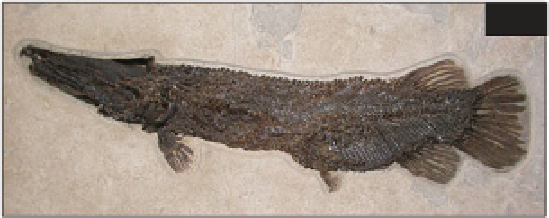Geoscience Reference
In-Depth Information
Common in the Lake Uinta deposits and
suggestive of lagoonal conditions, they
are also found in mass mortalities (see
above). Modern gar prefer shallow,
weedy, swampy areas which explains why
they are abundant in the deltaic and
stream deposits of Lake Uinta. Another
group of fish occurring in mass
mortalities are the trout perch
(
Erismatopterus
and
Amphiplaga
) which,
as their name suggests, are morpho-
logically intermediate between trout and
perches. Perhaps, like modern trout
perches, they were temperature sensitive
and suffered mass mortalities during the
hot summers.
Two groups of fish often found in
association (but interestingly not known
from Fossil Lake) are the bottom-
dwelling suckers and catfish. As the name
suggests the sucker,
Amyzon
(up to 30 cm
[12 in] in length), had no teeth in its
jaws and sucked food from the lake
bottom with its thick, fleshy lips. It did,
however, have teeth on its gill arches
which it used to crush invertebrates. The
catfish,
Astephus
and
Hypsidoris
, with a
maximum length of 30 cm (12 in), are
recognized by their stout dorsal and
pectoral spines which are serrated on
one edge. Again they are found in mass
mortalities.
193
193 The freshwater stingray
HeliobatisPC. Length 30 cm
1 ft.
194
194 The gar Atractosteus
TFSK. Length 2.1 m 7 ft.





Search WWH ::

Custom Search